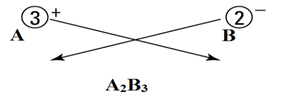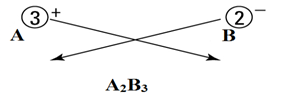
(a)
Interpretation:
The formulas of all the compounds containing the cation Ba+2 and anions I-or N3 - needs to be determined.
Concept introduction:
There are two types of ions:
Cations = These are positively charged formed by losing electrons.
Anions = These are negatively charged ions formed by gaining electrons.
Cations and anions combine to form ionic compounds.
Steps to write chemical formula from ions:
Let’s say there are two ions A+3 and B-2.
- Identify the cations and anions.
Cations are positively charged, and anions are negatively charged.
Here
A+3 = cation
B-2 = anion
- Write both cation and anion together (placing cation first) as:
- Put a value in the subscript of anion which is equal in magnitude with charge of cation and in the subscript of cation, put the value equals to magnitude of charge of anion as:

- If the subscript of anions and cations are multiple of a common number, then make it the smallest whole number ratio.
(b)
Interpretation:
The formulas of all the compounds containing the cations Fe+2 or Fe+3 and anion O-2 needs to be determined.
Concept introduction:
There are two types of ions:
Cations = These are positively charged formed by losing electrons.
Anions = These are negatively charged ions formed by gaining electrons.
Cations and anions combine to form ionic compounds.
Steps to write chemical formula from ions:
Let’s say there are two ions A+3 and B-2.
Cations are positively charged, and anions are negatively charged.
Here
A+3 = cation
B-2 = anion
- Write both cation and anion together (placing cation first) as:
- Put a value in the subscript of anion which is equal in magnitude with charge of cation and in the subscript of cation, put the value equals to magnitude of charge of anion as:

- If the subscript of anions and cations are multiple of a common number, then make it the smallest whole number ratio.
Trending nowThis is a popular solution!

Chapter 2 Solutions
EBK CHEMISTRY: PRINCIPLES AND REACTIONS
- Concentration (mg/l) Peak Area 0 158 10 10241 20 18425 30 26457 40 37125 50 44256 60 56124 Question: Determine the regression equation (a and b coefficients) from first principlesarrow_forwardConcentration (mg/l) Peak Area 0 158 10 10241 20 18425 30 26457 40 37125 50 44256 60 56124 You have been asked to determine the concentration of citral in a highly valued magnolia essential oil. QUESTION: Calculate the concentration of citral in your highly valued magnolia essential oil which returns a peak area of 41658arrow_forwardNeed help with these problems...if you can please help me understand problems E & F.arrow_forward
- Please help me solve these problems. Thank you in advance.arrow_forwardPredict the products of this organic reaction: O N IN A N + H2O + HCI ? Specifically, in the drawing area below draw the skeletal ("line") structure of the product, or products, of this reaction. If there's more than one product, draw them in any arrangement you like, so long as they aren't touching. If there aren't any products because this reaction won't happen, check the No reaction box under the drawing area. 田 C + Explanation Check Click and drag to start drawing a structure. C © 2025 McGraw Hill LLC. All Rights Reserved. Terms of Use | Privacy Centerarrow_forward6. For each of the following, fill in the synthesis arrows with reagents and show the intermediates. You DO NOT need to use the same number of arrows that are shown (you may use more or less), but the product must be formed from the reactant. Then write the mechanism of one step in the synthesis (you can choose which step to write the mechanism for), including all reagents required, clearly labeling the nucleophile and electrophile for each step, and using curved arrows to show the steps in the mechanism. a. b. OHarrow_forward
- Draw the productsarrow_forwardDraw the correct productsarrow_forwardE Organic Chemistry Maxwell Draw the correct products, in either order, for the ozonolysis reaction: 1) O3, CH2Cl2, -78 °C Product 1 + Product 2 2) Zn, HOAc Draw product 1. Select Draw Templates More C H O presented by M Draw product 2. Erase Select Draw Templates M / # # carrow_forward
- ✓ edict the products of this organic reaction: ---- ။ A CH3–C−NH–CH2–C−CH3 + KOH ? Specifically, in the drawing area below draw the condensed structure of the product, or products, of this reaction. If there's more than one product, draw them in any arrangement you like, so long as they aren't touching. If there aren't any products because this reaction won't happen, check the No reaction box under the drawing area. Explanation Check Click anywhere to draw the first atom of your structure. C 2025 McGraw Hill LLC. All Rights Reserved. Terms of Use | Privacy Center | Accessibiliarrow_forwardPredict the product of this organic reaction: A HO-C-CH3 + CH3NH2 P+ H2O Specifically, in the drawing area below draw the condensed structure of P. If there is no reasonable possibility for P, check the No answer box under the drawing area. Explanation Check Click anywhere to draw the first atom of your structure. marrow_forwardH 1) OsO4, pyridine 2) Na2SO3 or NaHSO3 in H₂O 2 productsarrow_forward
 Introductory Chemistry: An Active Learning Approa...ChemistryISBN:9781305079250Author:Mark S. Cracolice, Ed PetersPublisher:Cengage Learning
Introductory Chemistry: An Active Learning Approa...ChemistryISBN:9781305079250Author:Mark S. Cracolice, Ed PetersPublisher:Cengage Learning Chemistry: Principles and ReactionsChemistryISBN:9781305079373Author:William L. Masterton, Cecile N. HurleyPublisher:Cengage Learning
Chemistry: Principles and ReactionsChemistryISBN:9781305079373Author:William L. Masterton, Cecile N. HurleyPublisher:Cengage Learning

